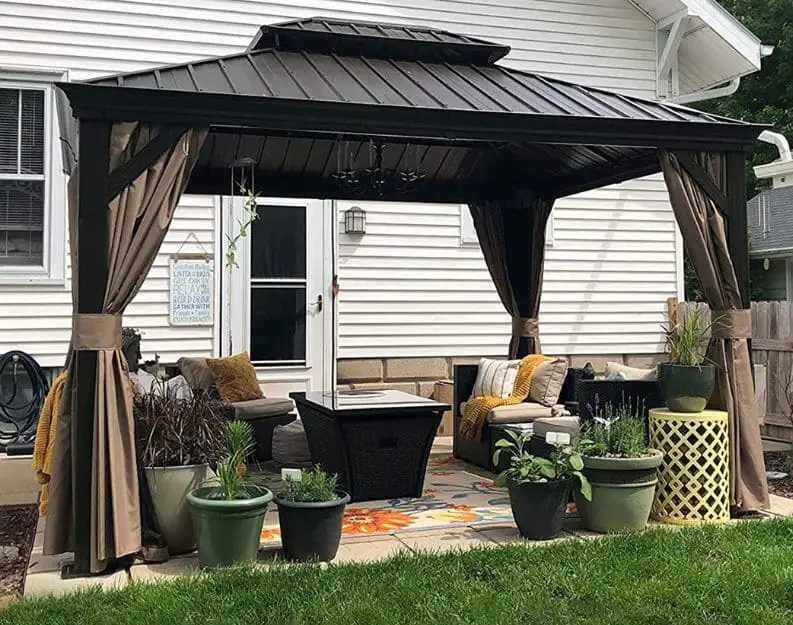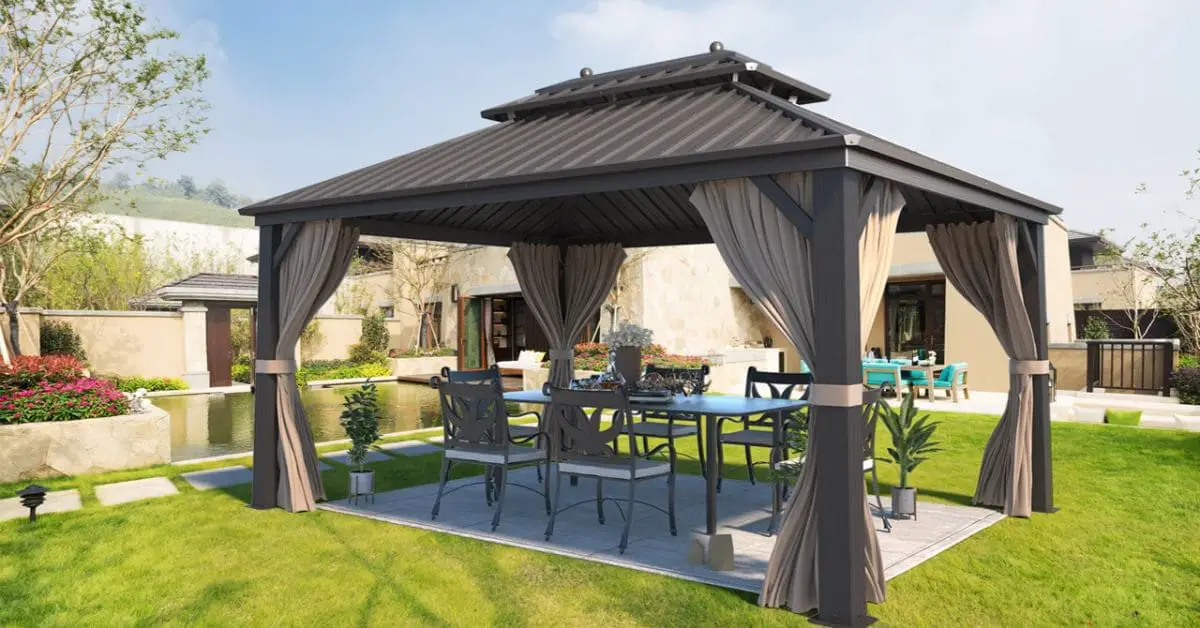A hard top gazebo is a popular outdoor structure that provides shade, shelter, and a place to relax or entertain guests. However, when selecting a hard top gazebo, it is important to consider the weight of the structure as it can impact its overall stability.
The weight of a gazebo is determined by the materials used in its construction, such as steel or aluminum frames, polycarbonate or tempered glass panels, and other features like curtains or mosquito netting.
The stability of a hard top gazebo is crucial for safety reasons, as it can prevent the structure from tipping over or collapsing in strong winds or heavy rains.
The weight of the gazebo affects its ability to withstand weather conditions and external forces, such as gusts of wind.
Additionally, a heavier gazebo may require a stronger and more stable base or foundation to prevent movement or shifting, especially if it is placed on uneven ground.
In this article, we will explore how the weight of a hardtop gazebo affects its stability and discuss some tips on how to choose a gazebo that is safe and secure for outdoor use.
How does the weight of a hardtop gazebo affect its stability? The weight of a hard top gazebo is an important factor in its stability. A heavier gazebo will have better wind resistance, remain stable on uneven terrain, and be more durable over time.
The recommended weight will depend on factors such as size, wind conditions, and terrain. However, there are alternative methods to increase stability, such as anchoring and additional support.
How does the weight of a hardtop gazebo affect its stability? Easy Guide

When you buy a hard top gazebo, it is important to think about how heavy it is because it affects how stable the gazebo will be.
The weight of the gazebo depends on what materials are used to build it. The heavier the gazebo, the more stable it will be, and it will be less likely to fall over or break during bad weather.
However, a heavier gazebo may need a stronger and more stable base to stop it from moving around, especially if the ground it is on is not flat.
To make sure your gazebo is safe and secure, you should check the manufacturer’s instructions and make sure it is anchored properly.
You should also check and tighten all the bolts and anchors regularly and remove any curtains or netting during heavy wind or rain to make sure the gazebo doesn’t get blown over.
Factors that affect stability of a hardtop gazebo
When it comes to purchasing a hard top gazebo, stability is a crucial consideration to ensure safety and longevity.
The stability of a hard top gazebo can be affected by several factors, including wind speed and direction, terrain, quality of materials used, and weight of the gazebo.
we will explore each of these factors and how they can impact the stability of a hard top gazebo.
Wind speed and direction
One of the most significant factors that can affect the stability of a hard top gazebo is wind speed and direction. Strong winds can cause a gazebo to wobble or even topple over if it is not properly anchored or if it is too lightweight.
The direction of the wind can also play a role in the stability of the gazebo. If the gazebo is facing directly into the wind, it will experience greater force than if it is angled or sheltered from the wind.
To ensure stability in high winds, it is recommended to anchor the gazebo securely to the ground using stakes, weights, or other anchoring methods. Additionally, it may be helpful to position the gazebo in an area that is sheltered from strong winds, such as near a building or under trees.
Terrain

The terrain on which the gazebo is placed can also affect its stability. Uneven or sloping ground can cause a gazebo to be unstable, particularly if it is not level.
The weight distribution of the gazebo can also be impacted by the terrain, potentially causing one side to be heavier than the other.
To ensure stability on uneven terrain, it is important to level the ground before setting up the gazebo. This can be done using a shovel or other landscaping tools. In some cases, it may be necessary to build a platform or foundation to ensure a level surface for the gazebo.
Quality of materials used
The quality of materials used in the construction of a hard top gazebo can also impact its stability. Cheap or low-quality materials may be less durable and more prone to damage from wind, rain, or other weather conditions.
In addition, materials that are not designed to withstand outdoor conditions may degrade over time, reducing the stability of the gazebo.
When selecting a hard top gazebo, it is important to choose one that is made from high-quality materials, such as steel or aluminum.
These materials are durable and designed to withstand outdoor conditions, making them ideal for use in a hard top gazebo. It is also important to choose a gazebo with a sturdy frame and strong, weather-resistant roof panels.
Weight of the gazebo
The weight of the gazebo is perhaps the most critical factor in ensuring its stability. A lightweight gazebo may be more prone to wobbling or toppling over in high winds or on uneven terrain.
A heavier gazebo, on the other hand, will be more stable and less likely to be affected by wind or other external factors.
To ensure stability, it is recommended to choose a hard top gazebo that is appropriately weighted for its size and intended use.
This may involve adding additional weight to the gazebo using sandbags, weights, or other anchoring methods. It is also important to ensure that the gazebo is evenly weighted to prevent it from tipping over or becoming unstable.
Importance of weight in the stability of a hard top gazebo
The weight of a hard top gazebo plays a critical role in ensuring its stability. A gazebo that is too lightweight may be prone to wobbling or even toppling over in high winds or on uneven terrain, while a heavier gazebo will be more stable and less likely to be affected by external factors.
we will explore the importance of weight in the stability of a hard top gazebo, including how weight affects wind resistance, stability on uneven terrain, and the durability of the gazebo.
How weight affects wind resistance

Wind resistance is a critical consideration when it comes to the stability of a hard top gazebo. Strong winds can cause a gazebo to wobble or even topple over if it is not properly anchored or if it is too lightweight.
The weight of the gazebo plays a critical role in its wind resistance, with heavier gazebos being more resistant to wind.
The reason for this is that a heavier gazebo will be less affected by the force of the wind. The additional weight provides greater stability and makes it more difficult for the wind to move the gazebo.
In contrast, a lightweight gazebo will be more susceptible to wind and may wobble or even topple over in high winds.
To ensure wind resistance, it is recommended to choose a hard top gazebo that is appropriately weighted for its size and intended use. Additionally, it is important to anchor the gazebo securely to the ground using stakes, weights, or other anchoring methods.
How weight affects stability on uneven terrain
The stability of a hard top gazebo can also be affected by the terrain on which it is placed. Uneven or sloping ground can cause a gazebo to be unstable, particularly if it is not level.
The weight distribution of the gazebo can also be impacted by the terrain, potentially causing one side to be heavier than the other.
The weight of the gazebo can help to mitigate these issues by providing greater stability and balance. A heavier gazebo will be less affected by the slope or unevenness of the terrain, making it more stable overall.
In contrast, a lightweight gazebo may wobble or even topple over uneven terrain, particularly if it is not properly anchored.
To ensure stability on uneven terrain, it is important to level the ground before setting up the gazebo.
This can be done using a shovel or other landscaping tools. In some cases, it may be necessary to build a platform or foundation to ensure a level surface for the gazebo.
Additionally, it may be necessary to anchor the gazebo more securely to the ground to ensure that it remains stable.
How weight affects the durability of the gazebo
The weight of a hard top gazebo can also impact its durability over time. A heavier gazebo will generally be more durable and long-lasting than a lightweight gazebo. This is because heavier gazebos are generally made from higher quality materials and are designed to withstand outdoor conditions.
A heavier gazebo will be less susceptible to damage from wind, rain, or other weather conditions. Additionally, heavier gazebos are less likely to degrade over time, ensuring that they remain stable and secure for years to come.
To ensure the durability of a hard top gazebo, it is important to choose one that is made from high-quality materials and designed to withstand outdoor conditions.
Additionally, it is important to choose a gazebo with a sturdy frame and strong, weather-resistant roof panels.
By selecting a heavier gazebo, you can ensure that it will remain stable and durable over time, even in harsh weather conditions.
Recommended weight for a hard top gazebo
When it comes to the weight of a hard top gazebo, there is no one-size-fits-all answer. The recommended weight will depend on a variety of factors, including the size of the gazebo, the expected wind conditions, and the terrain on which it will be placed.
we will explore the factors to consider in determining the recommended weight for a hard top gazebo, the ideal weight range, and possible alternatives to increasing weight for stability.
Factors to consider in determining the recommended weight

There are several factors to consider when determining the recommended weight for a hard top gazebo. These factors include the size of the gazebo, the expected wind conditions, and the terrain on which it will be placed.
The size of the gazebo is perhaps the most important factor to consider. A larger gazebo will require more weight to ensure stability than a smaller one.
Additionally, if the gazebo is designed to accommodate seating or other heavy items, it will require more weight to ensure stability.
The expected wind conditions are also an important consideration. If the gazebo will be placed in an area with high winds, it will require more weight to ensure stability.
The wind speed and direction should be taken into account when determining the recommended weight for the gazebo.
The terrain on which the gazebo will be placed is another important factor to consider. Uneven or sloping terrain will require more weight to ensure stability than a flat, level surface.
Additionally, if the ground is soft or sandy, more weight may be necessary to ensure that the gazebo remains stable.
Ideal weight range for a hard top gazebo
While there is no one-size-fits-all answer to the ideal weight range for a hard top gazebo, there are some general guidelines that can be followed.
As a rule of thumb, a hard top gazebo should weigh at least 50 pounds per square foot of roof area. For example, a 10×10 gazebo with a 100 square foot roof should weigh at least 500 pounds.
It is important to note that this is just a guideline, and the recommended weight may vary depending on the factors discussed above.
For example, a gazebo that will be placed in an area with high winds or on uneven terrain may require more weight to ensure stability.
Possible alternatives to increasing weight for stability
Increasing the weight of a hard top gazebo is one way to ensure stability, but it is not always practical or feasible. Fortunately, there are other options available for increasing the stability of a gazebo.
One option is to anchor the gazebo more securely to the ground. This can be done using stakes, weights, or other anchoring methods. For example, sandbags or concrete blocks can be used to weigh down the legs of the gazebo.
Another option is to add additional support to the gazebo. This can be done by adding cross braces or diagonal supports to the frame. This will help to distribute the weight of the gazebo more evenly and increase its stability.
Finally, it is important to choose a hard top gazebo that is designed for outdoor use and made from high-quality materials. A well-made gazebo will be more durable and less likely to be affected by external factors such as wind or rain.
FAQs
Q.1 What factors contribute to the weight of a hard top gazebo?
The weight of a hard top gazebo is primarily determined by the materials used in its construction, such as the frame, roof panels, and any additional features like curtains or netting. Heavier materials like steel frames and tempered glass panels will increase the overall weight of the gazebo.
Q.2 How does the weight of a hard top gazebo affect its stability?
The weight of a hard top gazebo is directly proportional to its stability. A heavier gazebo will be more stable and less likely to tip over or collapse in strong winds or heavy rains. Additionally, a heavier gazebo may require a stronger and more stable base or foundation to prevent movement or shifting, especially if it is placed on uneven ground.
Q.3 Can a lightweight hard top gazebo be stable?
Yes, a lightweight hard top gazebo can be stable if it is properly anchored and has a strong base or foundation. However, lightweight gazebos may be more susceptible to wind damage and may not be as durable as heavier models.
Q.4 How do I determine the appropriate weight for a hard top gazebo?
The appropriate weight for a hard top gazebo will depend on several factors, including the expected weather conditions, the size of the gazebo, and the strength of the base or foundation. It is important to consult the manufacturer’s specifications and installation instructions to ensure that the gazebo is properly anchored and stable.
Q.5 What are some tips for maintaining the stability of a hard top gazebo?
To maintain the stability of a hard top gazebo, it is important to regularly inspect and tighten all bolts and anchors. Additionally, ensuring that the base or foundation is level and stable can help prevent movement or shifting. During periods of high winds or heavy rains, it may be advisable to remove any additional features like curtains or netting to reduce the wind load on the gazebo.
Conclusion
In conclusion, the weight of a hard top gazebo plays a crucial role in its stability. Wind speed and direction, terrain, quality of materials used, and weight of the gazebo are all factors that affect its stability. It is important to consider the weight of the gazebo when looking for a stable option for outdoor use.
A heavier gazebo provides better wind resistance, stability on uneven terrain, and durability. When determining the recommended weight, factors such as size, wind conditions, and terrain must be considered.
However, alternatives such as anchoring and additional support can also be used to increase stability. Overall, understanding the importance of weight in the stability of a hard top gazebo is essential for a safe and enjoyable outdoor experience.
We hope this guide has helped you understand how the weight of a hard top gazebo affects its stability. If you have any questions, please feel free to ask in the comments below.


